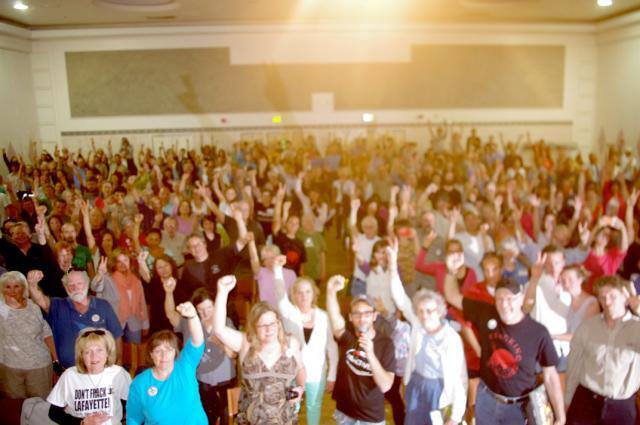
The audience at the "Gasland Part II" screening in Boulder standing with director Josh Fox, fists in the air.
Fracking has been an incredible boon for everyone in the United States. For the first time in decades, heavy manufacturing companies, such as Nucor Steel, are coming back to the United States to take advantage of low energy costs. The rest of the world stands to benefit from fracking, too. Fracking has the potential to free eastern Europe from its dependence on Russia’s gas supply, and the political bullying that comes with it. Japan and China can lower their natural gas costs, which are currently four times what we pay in the United States. In Africa, where poverty and disease go hand in hand, cheap energy can help to fuel and build the water purification and modern sanitation systems we enjoy in the developed world.
What makes people like Josh Fox–the director of “Gasland”–so scary, is that they have found a way to fight this amazing, life-promoting technology while evading honest discussion. They have developed and mastered the art of making terrifying “documentaries” using film techniques straight out of Hollywood horror films. Let me explain.
Last night I saw the sixth-ever showing of Fox’s newest film, “Gasland Part II.” The sequel did not disappoint. Just like the first film, the sequel showed Fox’s mastery of the techniques used by modern low-budget horror films. Borrowing a technique from the famous zombie apocalypse thriller “28 Days Later,” “Gasland Part II” begins with a rapid succession of choppy, blurred TV clips, over a crescendo of deep base tones resembling an ever-accelerating heartbeat. Then, the moment the audio and visuals hits their climax and the audience could not possibly take anymore, there is a sudden, abrupt and eerie silence. This leaves the audience in temporary state of extreme psychological discomfort, like the feeling of someone groping around in a pitch-black unfamiliar room. Now they are ready for Josh Fox to show them the light.
These techniques are not limited to the beginning of the film; Fox uses them throughout. Later, while showing flames coming off the top of a water well, a deep rumbling base sound swept through the room like what you would hear while watching a space shuttle launch in an IMAX theater. It was a loud, deep rumble, making it feel like the whole room was shaking. Of course, the real sound of the flame had been dubbed over using film editing software, which just shows another way in which Fox effectively uses his “artistic license” to shade the truth.
Another technique that caught my attention was the way Fox juxtaposed images of children with images of heavy machinery, making it seem as though we have to make an either-or choice between children and industry. This was straight out of the Hollywood blockbuster “Terminator II,” where images of children’s playgrounds and the sound of children laughing are contrasted with those of an industrial wasteland future dominated by killer robots. Truthfully, Fox does not go to this extreme–that would be too obvious–but the sheer amount of footage showing children walking up to well sites and posing before bulldozers would be inexplicable if it were not meant to give a similar impression: “Machines or children? Which side are you on?” (There was even a unexplained clip showing a three-legged dog. How can you not feel sympathetic toward a three-legged dog? But how many audience members will stop to wonder what that has to do with fracking?)
What astounded me most was not the techniques themselves but seeing their effect on the audience. At one point the audience was so worked into a fervor that there was a sudden outburst of boos and yelling triggered by a clip of Obama announcing an “all of the above” energy strategy. For the first time in my life, I actually heard someone (sitting somewhere to my left) let out an angry hiss. When I first read George Orwell’s book, “1984,” I remember thinking, in response to a scene where fictional characters hiss out at images of a character Emmanuel Goldstein, “the Enemy of the People,” that it sounded absurd. “Hissing?,” I thought, “Who hisses? That’s weird.” But apparently some people do, and I’ve just been watching the wrong films with the wrong crowds.
Honestly, I don’t know what to do about these kinds of films or how to protect audience members from the kinds of psychological manipulation they employ. In this case, I stood up during the Q&A and urged people to watch “FrackNation,” a more honest pro-fracking documentary, but I’m not sure that alone was enough. Maybe I’ll have an actual horror film director take a look at Fox’s methods to verify and make clear that this is what he is doing. If anyone has some better ideas, please feel free to share.
Frack On!







